NIL
NCAA set to allow college basketball schedules increase to 32-game season beginning in 2026-27
College basketball’s regular season is set to expand. Barring an unexpected and extremely unlikely motion to vote against, the NCAA Division I Council will approve on Wednesday an increase from 31 to 32 games, beginning with the 2026-27 season, sources told CBS Sports. The vote is a rubber-stamp move after the Division I Men’s and […]
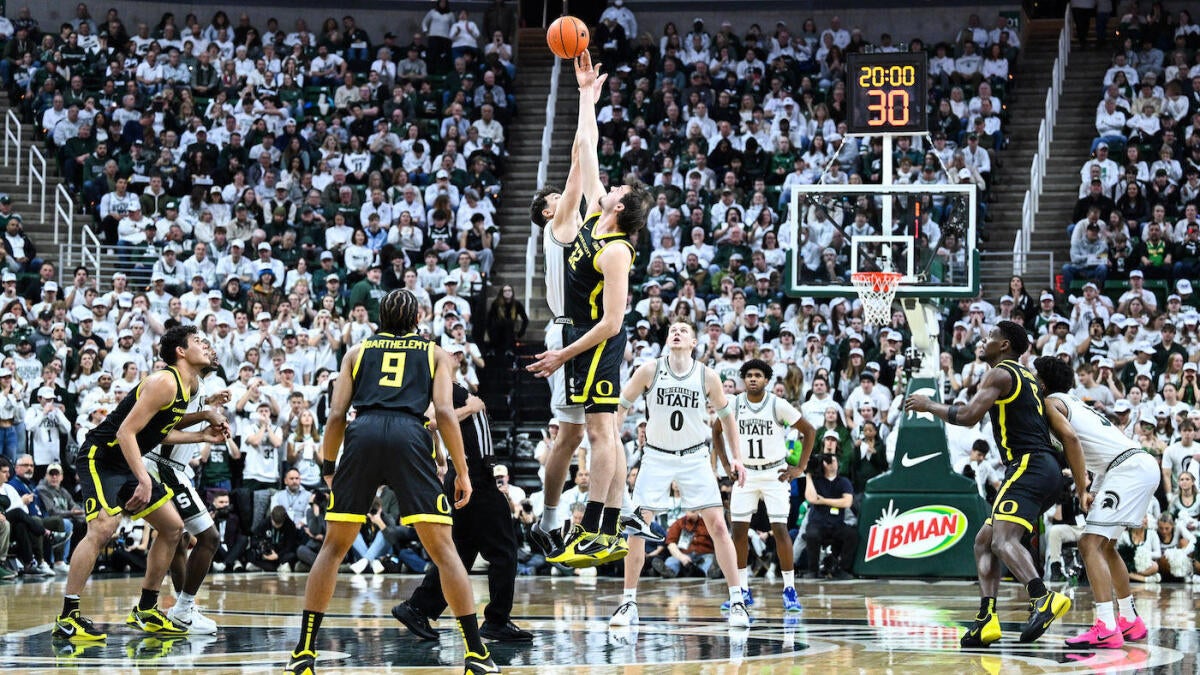
College basketball’s regular season is set to expand. Barring an unexpected and extremely unlikely motion to vote against, the NCAA Division I Council will approve on Wednesday an increase from 31 to 32 games, beginning with the 2026-27 season, sources told CBS Sports. The vote is a rubber-stamp move after the Division I Men’s and Women’s Basketball Oversight Committees voted in favor of the change back in late March.
The update comes after a 19-year run of a 31-game maximum for the regular season. Since 2006-07, the format was 28 or 29 predetermined games, plus allowance for three-game or two-game multi-team events added in (making it a 31-game cap). Starting in 2026, teams won’t be required to play 32 games, they’ll merely have the option to do so — with most expected to up their quota by one under the new rule.
The increase will also push teams that make the NCAA championship game to play in as many as 41 games.
The primary issue driving the decision to go to 32 is tied to multi-team events (MTEs), which had become more restrictive with some of their NCAA guidelines due to conference expansion leading to schools from the same leagues playing in the same events. That was previously not allowed (but now is via a waiver). Additionally, sometimes three-game MTEs were roadblocks for a variety of schools trying to work through the logistics of nonconference scheduling.
Brandon Roy Jr. commits to Washington, son of ex-NBA star adds to loaded Huskies recruiting class
Carter Bahns
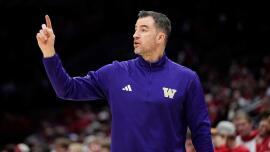
The 32-game limit will include all games, meaning contests against non-Division I opponents also count toward the total. Additionally, this change will allow big in-season tournaments — like the NIL-incentivized Players Era Festival — to be able to schedule three- or four-game MTEs. Players Era will be staged for a second time this November, increasing to 18 teams, and is hoping to balloon to a 32-team mega event starting in 2026.
By going to a 32-game model, the extra game is will ease restrictions and allow more opportunity for programs to schedule as needed, with the potential for more high-profile matchups in the regular season. What’s more, the additional game should also enable more teams to bring back nonconference opportunities in January or February, something we’ve seen with Duke playing Illinois in February of this year and Duke facing Michigan in February 2026.
Multiple high-major coaches told CBS Sports in recent months that they are actively pursuing and hoping to play a nonconference game in the midst of the conference season moving forward, finding benefits in advance of postseason play in March.
The move to 32 is also, naturally, being done with money in mind. One more game will mean one more home and/or neutral-court opportunity for a lot of high-major programs, which are now looking for revenue in any way possible after the House case settlement ushered in revenue sharing for college athletes. Home gates at games bring in more revenue to be able to pay athletes. Sources around college athletics speculated that the increase to 32 games is just the first phase, and that by early-to-mid 2030s the regular season could go to 34 or 35 games prior to the start of conference tournament play.
NIL
MAC upsets are a treasured college football tradition. Will they go extinct in the new era?
DETROIT — Like a No. 14 seed beating a No. 3 seed in March, a team from the Mid-American Conference knocking off one of college football’s big spenders is the kind of upset that captivates an entire sport. One of those indelible upsets happened last season when Northern Illinois stunned fifth-ranked Notre Dame in South […]

DETROIT — Like a No. 14 seed beating a No. 3 seed in March, a team from the Mid-American Conference knocking off one of college football’s big spenders is the kind of upset that captivates an entire sport.
One of those indelible upsets happened last season when Northern Illinois stunned fifth-ranked Notre Dame in South Bend. NIU’s victory, shocking at the time, became even more mind-bending as Notre Dame reeled off 13 consecutive victories on its way to the championship game of the College Football Playoff.
The formula for these massive upsets hasn’t changed, but the 2025 season could bring a new wrinkle: the first underdog to upset a team with a $30 million payroll. NIU’s Thomas Hammock has a few words of advice for whichever lucky coach finds himself in that position.
“I should have taken more time to enjoy it,” Hammock said. “That’s a regret that I have, because I did not enjoy it personally. I was on to the next opponent. As I reflect, I’m proud of the accomplishment. We don’t have a big NIL budget. We don’t have all these extra things that most people have. We came together and found a way to get it done.”
The approval of the House settlement and the arrival of revenue sharing reinforced an age-old divide between the upper echelon of college football and teams in the middle class. The bluebloods have always had bigger budgets, nicer facilities, larger staffs and more talented rosters. Now they’ll have bigger payrolls, too, measured not just in third-party NIL deals but also in direct payments from schools to the players.
The big schools will pay out the full $20.5 million allowed under the settlement terms, with the lion’s share going to football players. Smaller schools are likely to distribute a fraction of that. If that means programs in the MAC are at a disadvantage, well, what else is new?
“When I was a little kid, Texas still had advantages, and Michigan and Ohio State,” Miami (Ohio) coach Chuck Martin said. “There’s always been a gap. The difference between Michigan and Purdue is a gap. Is it probably getting wider? Yeah, but there’s always been the haves and the have-nots.”
The Big Ten’s September schedule features a heavy rotation of MAC opponents. Those games are typically lopsided, which makes the occasional upset — Toledo over Michigan in 2008, Eastern Michigan over Illinois in 2019, Bowling Green over Minnesota in 2021 — even more special.
Those MAC matchups will be played as long as Big Ten teams need home games to pad their nonconference schedules. The long-term question is whether the forces unleashed by the House settlement will bring these schools closer together or push them further apart.
MAC commissioner Jon Steinbrecher suggested the arrival of revenue sharing might give bigger schools a taste of the tight margins that MAC programs know all too well. A wave of belt-tightening has already hit Power 4 programs as they trim staff and look for alternative funding sources to offset the millions that will be paid out to athletes.
“Given the new system we’re moving into, I think the pressures will be even higher at the upper level of the food chain,” Steinbrecher said. “I think they’re going to have very similar issues to what we will have.”
The best course of action, Steinbrecher said, is for the 10 FBS conferences to work together. The alternative scenario is that these new pressures drive the Power 4 conferences — and the two behemoths, the Big Ten and the SEC — to distance themselves from the smaller leagues further.
The implementation of the House settlement has been marked by clashes between collectives and the newly formed College Sports Commission, which is responsible for vetting NIL deals to prevent boosters from pouring unlimited money into the rosters of their favorite teams. President Donald Trump has also weighed in, issuing an executive order that aims to rein in a system that “reduces competition and parity by creating an oligarchy of teams that can simply buy the best players.”
In theory, MAC programs would stand to benefit if new rules make it harder for programs to lure the best Group of 5 players into the transfer portal with lucrative NIL offers. But coaches in the MAC understand the reality: If a big school wants one of their players, there’s only so much they can do.
“The boys that want to pay, they’ll just go back to cheating,” Martin said. “We’ll go full circle, from ‘This is going to legalize it’ to now we’re hampering them and they want to do more. So let’s just go back to showing up in a Speedway parking lot with a bag.”
Martin caused a stir last August when he said Alabama “stole” Miami’s kicker, alluding to the way Power 4 programs recruit players from the rosters of smaller schools. Martin was amused by the reaction to those comments, as he merely said aloud what everyone in the sport already knows.
Programs employ staffers who analyze the rosters of every MAC program and identify the players who might be good enough to play at a higher level. Martin got a reminder of that when he called a friend at a bigger school and realized his friend knew Miami’s personnel almost as well as he did.
“I had trouble last year when I said Alabama stole our kicker,” Martin said. “It wasn’t (just) Alabama. I got a receiver stolen by Texas Tech. That’s what’s going on. ‘Tampering’ is such a nice term for stealing our players.”
With so many advantages, Power 4 programs have no excuses for losing to a team from the MAC. The money being spent on roster building means more pressure on coaches and players to avoid these unsightly upsets and, in all likelihood, more backlash when a $30 million team loses to a team with a payroll closer to $1 million.
And make no mistake, it’s going to happen. Precise payroll numbers are difficult to pin down, but there are plenty of early-season opportunities for a MAC team to score a Big Ten upset. Miami opens the season with games at Wisconsin and Rutgers, Ball State opens at Purdue, and Northern Illinois plays at Maryland in Week 2. If you want to dream big, Central Michigan plays Michigan in Week 3, and Ohio plays at Rutgers and Ohio State in the first three weeks of the season.
By the numbers, Big Ten teams should win all of those games. But no matter how much they’re being paid, college athletes are never going to be as consistent as NFL players, Hammock said. All the money in the world can’t eliminate the distractions, pressures, and lapses in focus that, on a particular day, could allow a MAC team to shock the world.
“I don’t think fans understand that,” Hammock said. “They think, ‘If I throw more money at something, it’s going to be successful.’ That’s not how life works. That’s not how the game of football works. I think you’re going to continue to see upsets like you do (now), and you’re going to continue to see teams pay a lot of money for a roster and implode because they’re not prepared to deal with adversity.”
Hammock’s advice to any coach who shocks the world is to take a moment to soak it in. Life moves fast, and last year’s Northern Illinois team was a prime example. The Huskies lost four of their next six games after beating Notre Dame, then rallied for an 8-5 finish and a bowl victory against Fresno State. In early January, NIU announced it would leave the MAC after the 2025 season and take its football program to the Mountain West.
For programs with tight margins, every extra dollar helps.
“It is bittersweet, because I was a MAC player,” said Hammock, a former NIU running back. “I grew up in this conference. I love this conference. This conference helped mold and develop me. I think the world of the MAC, but as the landscape continues to change and evolve, you have to figure out a way to constantly move forward.”
(Photo: Matt Cashore / Imagn Images)
NIL
Rhett Lashlee doubles down on calling the SEC top-heavy: ‘It was a factual comment’
SMU head coach Rhett Lashlee made a few ears perk up in SEC country due to his comments about the league. He pointed out how the same six teams have taken home a conference championship since 1964. “Top-heavy” is the term Lashlee used to describe the SEC instead of “depth,” something you might hear others […]

SMU head coach Rhett Lashlee made a few ears perk up in SEC country due to his comments about the league. He pointed out how the same six teams have taken home a conference championship since 1964. “Top-heavy” is the term Lashlee used to describe the SEC instead of “depth,” something you might hear others say.
Less than a week later, Lashlee doubled down on what he said during ACC Kickoff in Charlotte. “It was a factual statement,” he said on The Paul Finebaum Show, diving into the topic a little more.
“It wasn’t a shot at anybody,” Lashlee said. “I spent six hours answering questions at ACC Kickoff Media Days last week. I think I mentioned in about two sentences and that’s what everybody took and ran with. I feel like I’ve got a respect for the SEC… I’ve got a lot of respect for the league. All I said was a comment and unfortunately, it was a factual comment. The same six schools have won that league for the last 60 years. It’s hard to argue parity if that’s the case.”
Lashlee played quarterback at Arkansas before starting his coaching career in Fayetteville. He was eventually a part of Gene Chizik‘s staff at Auburn, helping them win a national championship as a graduate assistant. Three years later, Lashlee was back on the Plains as the OC for Auburn‘s historic run under Gus Malzahn. But now at SMU and playing in the ACC, he is going to do whatever it takes to support his program.
Coaches going to bat for their conference is nothing new in college athletics. Basketball is usually the main culprit as seasons wear on, attempting to boost their own NCAA Tournament resume. More teams from your conference getting into the field helps your program and league immensely. And in the days of the College Football Playoff, football has become similar.
“I’m not necessarily saying the ACC’s better or worse,” Lashlee said. “I think the SEC’s a league I really respect, it’s done great things. But we’re in a day and age where, unfortunately, we’re forced to politic, almost like it’s a contest or a pageant, to get into the Playoff.
“When that’s the case and one league is considered to maybe need preferential treatment for bids because of their depth, we’ve got to look at the facts. It’s not a comparison of league vs. league — I think that argument is not the reason. I think each year, teams should stand on their own production and success.”
The CFP’s future is still up for grabs. Folks from the Big Ten appear all in on the 4+4+2+2+1 model, while the other three power conferences are warming up to 5+11. Dec. 1 is when decisions will ultimately have to be made.
No matter what model gets implemented, Lashlee stands by what he said about the SEC. After all, the 4+4+2+2+1 model would give the SEC two more autobids than the ACC. Something no head coach in the ACC is going to be thrilled about.
NIL
Donald Trump stamps new NIL executive order weeks after House settlement
President Donald Trump signed an executive order July 24 establishing regulations for the NCAA’s name, image and likeness. The order, titled Saving College Sports, prohibits third-party, pay-for-play payments and clarifies college athletes are “amateurs, not employees.” “The future of college sports is under unprecedented threat,” Trump wrote. “Waves of recent litigation against collegiate athletics governing […]

President Donald Trump signed an executive order July 24 establishing regulations for the NCAA’s name, image and likeness. The order, titled Saving College Sports, prohibits third-party, pay-for-play payments and clarifies college athletes are “amateurs, not employees.”
“The future of college sports is under unprecedented threat,” Trump wrote. “Waves of recent litigation against collegiate athletics governing rules have eliminated limits on athlete compensation, pay-for-play recruiting inducements and transfers between universities, unleashing a sea change that threatens the viability of college sports.”
College athletes have been on the receiving end of NIL-based compensation from third-party vendors since 2021. After the House settlement in June, athletes can also receive pay directly from their universities.
In the eyes of fans, it’s led to unrest among college athletics. Athletes have prioritized finances over performance and transferred schools to earn higher paychecks. Decisions surrounding potential recruits have also been affected.
The University of Florida was supportive of Trump’s decision and released a statement July 25 backing the president.
“The attention President Trump and congressional leaders are giving to the future of college athletics is welcomed and appreciated,” Gators athletic director Scott Stricklin wrote. “Yesterday’s executive order underscores the growing recognition in Washington of the need to modernize the collegiate model.”
Trump’s order calls for ending third parties’ engagement in “pay-for-play” payments to athletes, which the executive order deems “improper.” However, it does not discern an athlete’s ability to receive compensation for the “fair market value” they might provide a brand.
Trump backs the ruling in the House settlement about advanced scholarship opportunities and highlights the importance of achieving representation in smaller, nonrevenue sports.
“This opportunity must be utilized to strengthen and expand non-revenue sports,” he wrote. “The third-party market of pay-for-play inducements must be eliminated before its insatiable demand for resources dries up support for non-revenue sports.”
The focus on revenue-generating sports like football and basketball has led to smaller sports like track and field, wrestling and swimming to be cut from several athletic programs. While not applicable at larger schools like UF, smaller schools have seen the elimination of nonrevenue sports on campus.
Washington State University, which is ranked No. 61 among college athletics programs in revenue generation, recently changed its track and field teams to a “distance-focused” program. It eliminated all field events like long and high jumps, javelin and shot put because of the strain from expanded NIL-compensation responsibilities.
Trump clarified athletes’ status on campus, urging Secretary of Labor Lori Chavez-DeRemer and the National Labor Relations Board to codify athletes as non-employees. Under President Joe Biden, the NLRB declared athletes as employees, which it rescinded earlier this year.
Enjoy what you’re reading? Get content from The Alligator delivered to your inbox
NCAA president Charlie Baker believes there are threats to college sports that federal legislation can address, he wrote in a statement.
“The Association appreciates the Trump administration’s focus on the life-changing opportunities college sports provide millions of young people, and we look forward to working with student-athletes, a bipartisan coalition in Congress and the Trump administration to enhance college sports for years to come,” Baker wrote.
Trump cannot unilaterally impose the rulings upon the NCAA. However, much of what he highlighted in the executive order aligns with the SCORE Act, which seeks to replace statewide “patchwork” NIL laws with a nationwide ruling.
The act was passed by the House Energy and Commerce Committee and the Committee on Education and the Workforce July 23 and will find itself on the House floor as soon as September.
Contact Luke Adragna at ladragna@alligator.org. Follow him on X @lukeadrag.
The Independent Florida Alligator has been independent of the university since 1971, your donation today could help #SaveStudentNewsrooms. Please consider giving today.
Luke Adragna is working his fifth semester at The Alligator and returns as the Summer 2025 assistant sports editor. In his free time, he enjoys hanging out with his cat Pete and researching niche professional athletes (shoutout Jacquizz Rodgers).
NIL
Deion Sanders jokes about Googling health issues: ‘You gon’ die dawg’
Deion Sanders revealed he was cured of bladder cancer Monday and the Colorado coach can make a little light of the situation at this point. He even joked about a Google search when he looked up his symptoms and what could happen. Basically, Sanders won’t exactly Google a health issue again, especially one of this […]

Deion Sanders revealed he was cured of bladder cancer Monday and the Colorado coach can make a little light of the situation at this point. He even joked about a Google search when he looked up his symptoms and what could happen.
Basically, Sanders won’t exactly Google a health issue again, especially one of this magnitude. Coach Prime was very thankful to his doctors and supporters and pleaded for others to get checkups. Heck, he even made a will because he thought this could be it.
Safe to say, the Google search could’ve accelerated those fears. Although, Sanders did joke about it a bit, just to remove any tension during his press conference.
“Well, the initial thing you do is what we all do. We Google, and that’s the wrong thing to do, because they tell you, ‘you gon’ die dawg,’” Sanders said, talking next to Dr. Janet Kukreja. “I mean, like they pretty much say that when you Google it and you don’t want to see that mess, whoever doing Google, you may want to change it up, because that ain’t the thing to look at when you’re going through what I went through. Like, ‘you got about 30 days, man,’ like, that’s the way it seems like it’s talking to you, and you don’t want that.
“And, you know you gotta, that’s why you gotta rely on your faith. You gotta rely on your faith and these wonderful people that’s telling you the truth. Like dog, shoot it straight. You know, when they start turning their head to the side, it’s getting ready to come. You know, it’s real. But she never falsified anything. She told me what was 100 and never said, ‘Well, you should do this. You should do that.’ She just explained everything to me so that I can make the decision that I felt like I needed to make for me and my family.”
Sanders acknowledged that “God is good” over and over and was truly thankful for all those around him. After this harrowing ordeal, he’s certainly ready to fully get back to football.
Sanders is getting ready for his third season at Colorado after leading the Buffs’ impressive turnaround in 2024. The program went 8-5 one year after a 4-8 record, making it to the Alamo Bowl. However, star players Shedeur Sanders and Travis Hunter are off to the NFL, meaning CU will have a new-look roster in 2025.
Coach Prime pointed out the impact of losing its quarterback and Heisman Trophy-winning two-way threat. That said, he thinks the rest of the group has a chance to be even better this season.
“They were great players. We have a better team,” Sanders said during an appearance on ESPN at Big 12 Media Days. “There’s a difference between great players and a great team. We have a better team, but we can never replace those type of players.”
NIL
Eligibility lawsuits lingering as start of season draws near
The stream of lawsuits across the country from college athletes trying to grab another season of eligibility appears ready to fizzle out for a bit. With fall football practice cranking up this week, players still hoping for a judge to allow them to take the field may be left waiting for a ruling that likely […]


The stream of lawsuits across the country from college athletes trying to grab another season of eligibility appears ready to fizzle out for a bit.
With fall football practice cranking up this week, players still hoping for a judge to allow them to take the field may be left waiting for a ruling that likely won’t help them compete again.
“We’re at a point in the summer where I think any athlete out there is going to know that it’s probably too late to file a case and be able to get relief on it,” said Sam Ehrlich, a professor of legal studies at Boise State studying the 2021 Alston ruling’s effect on college athletics.
Relief on a larger question surrounding eligibility may take a while, too: In cases from California to Wisconsin, judges have provided inconsistent results for players seeking legal help for another season, and it may very well be a topic settled for good by a higher court.
Vanderbilt quarterback Diego Pavia is perhaps the highest-profile athlete to win his court fight. The New Mexico State transfer sued the NCAA last fall, arguing that his junior college years should not count against his eligibility while citing the potential losses in earnings from name, image and likeness deals. U.S. District Judge William Campbell Jr. in Tennessee granted a preliminary injunction, ordering the NCAA to allow Pavia to play.
The NCAA is appealing Campbell’s decision but granted a blanket waiver that will allow an extra year of eligibility for Pavia and other athletes who played at non-NCAA Division I schools before enrollment if they were going to exhaust their eligibility this year.
Pavia won. Others, such as Wisconsin cornerback Nyzier Fourqurean, have lost or are in limbo.
Practice starts Wednesday for SEC members Vanderbilt and Tennessee. Chris Bellamy and Targhee Lambson are among four football players waiting on the same federal judge who gave Pavia another season of football last December.
Some schools have helped by filing waivers. Others wait and hold a spot, letting the athlete fight the legal battle.
“They’re just kind of in limbo in the transfer portal because schools don’t really know whether they’re going to have eligibility,” Ehrlich said. “It’s a really weird situation right now.”
The NCAA would like Congress to grant limited liability protection to help address all the lawsuits over eligibility. NCAA President Charlie Baker noted in June that athletes had five years to play four seasons for about a century, a situation that changed recently. Baker told The Associated Press then that the NCAA has won more of these cases than it lost.
“But the uncertainty it creates, the consequences of this for the next generation of young people if you play this thing out, are enormous,” Baker said. “Moving away from an academic calendar to sort of no calendar for college sports is hugely problematic.”
Duke Coach Manny Diaz thought such eligibility issues would be addressed after the House settlement, which took effect July 1.
“All I have been told is once they got House out of the way they are going to double back on a lot of these oddities and make sure eligibility is tied into a college career,” Diaz said at ACC media days. “We don’t want nine-year guys playing the sport.”
Thanks to the extra season granted due to covid-19, the college eligibility calendar has been scrambled a bit. Pavia will play his sixth season after starting with two at New Mexico Military Institute, a junior college, then two more at New Mexico State.
Hayden Large played three NAIA seasons at Dordt before transferring to Iowa, where he will be playing his sixth season this fall after he was granted another year.
Iowa Coach Kirk Ferentz sees a simple solution in giving players five years to play five seasons. He’s also in favor of players who start in junior college having an extra year, even as he sees the need for a limit even if he doesn’t know what that should be.
“If a guy during his first year ends up being able to play five or six games, why not let him play?” Ferentz said. “It’s all about creating opportunity, in my mind. I’ve never understood the rationale for not doing that.”
Ehrlich is attempting to track all lawsuits against the NCAA, ranging from the House settlement; name, image and likeness litigation; college athletes as employees; and Title IX lawsuits, along with other cases. Ehrlich has tracked more than a dozen lawsuits involving eligibility, and common factors are hard to come by.
He saw three very different rulings from judges appointed by President Donald Trump. Standards of evidence for a preliminary injunction also have varied from judge to judge. Three cases have been appealed, with other motions helping delay some waiver requests.
Ehrlich said there remains the chance a case lands before the U.S. Supreme Court.
“I don’t see these cases drying up anytime soon,” Ehrlich said.

NIL
Joel Klatt ranks Top 10 players in college football entering 2025 season
Fox Sports’ Joel Klatt ranked the Top 10 players in college football ahead of the 2025 college football season. Some programs even have multiple players on this list! Skill guys, linemen, you name it! Klatt scoured across college football to find the 10 best players across the sport going into the fall. Without further ado, […]

Fox Sports’ Joel Klatt ranked the Top 10 players in college football ahead of the 2025 college football season. Some programs even have multiple players on this list!
Skill guys, linemen, you name it! Klatt scoured across college football to find the 10 best players across the sport going into the fall.
Without further ado, let’s dive into the best players in college football. We start in the Big Ten!
Smith broke out as a freshman and even before he stepped on a college football field, people knew he was special. He helped Ohio State capture last year’s national championship and look to add at least one more before he heads to the 2027 NFL Draft.
Last year, Smith reeled in 76 catches for 1,315 yards, 15 touchdowns and 17.3 yards per catch. He’ll be in Heisman discussions this season.

The second best player in college football is Smith’s teammate, Caleb Downs. Downs transferred in from Alabama last season after a standout freshman year in 2023.
Klatt already pegged him as the best defensive back in the game with his coverage skills and tackling ability. He was NFL-ready last year, but could be a top 10 pick by the time spring rolls around.
Klubnik had the best year of his college football career in 2024. Klatt has him No. 3 overall and the top QB in the nation.
It took him a few years, but the Clemson signal caller really slinged it last season, helping the Tigers win the ACC and get to the CFP. He threw 36 touchdowns, just six picks and had nearly 3,700 yards.
Manning is already in the top five college football players per Klatt. He had limited action in terms of starting under center, but he has the tools.
It’s just about Manning proving it over the course of a full season with a team that has national title expectations. If he does just that, he might skyrocket to the top spot and maybe actually go to the 2026 NFL Draft, rather than play another year at Texas.
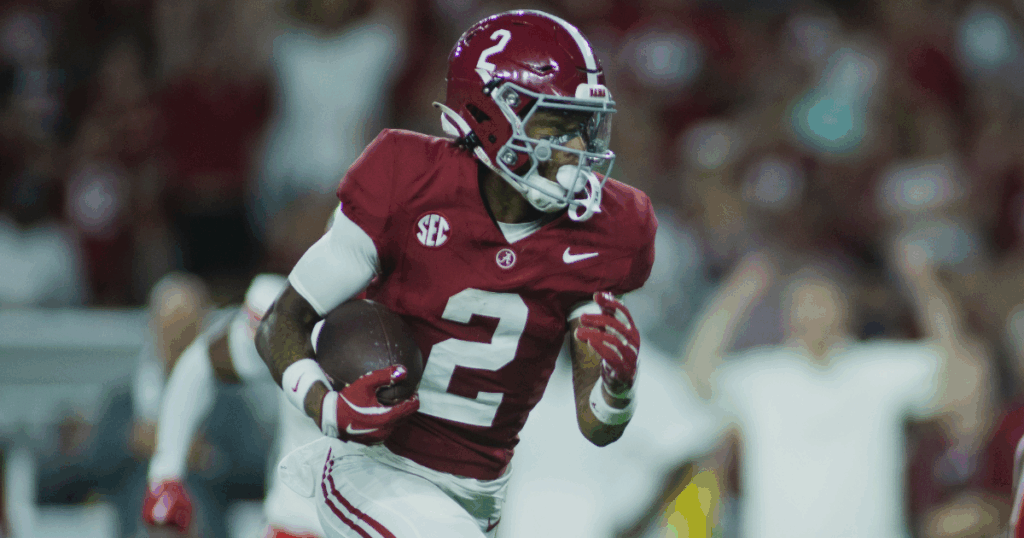
If Smith is the best wide receiver in college football then Williams is a close second. Also only a sophomore, Williams’ breakout came against Georgia last season.
So not only did people obsess over his skill, they did the same with his age considering he was playing college football at 17. Insane. Anyway, Williams finished his freshman year with 48 catches, 865 yards, eight touchdowns and 18 yards per catch.
The best running back in college football comes from Notre Dame. Love helped the Fighting Irish get to the College Football Playoff national championship last season and will certainly be in the Heisman conversation this fall.
As a sophomore, Love got more than double the work as a freshman. He had 163 carries for 1,125 yards, 17 touchdowns and 6.9 yards per catch.
Hill Jr. is a menace on defense and could be key to the Longhorns winning a national title this year. Going into Year 3, he’s poised for a career year.
One of the best, if not the best, linebacker in college football, Hill really stood out through 16 games last season. He had 113 tackles, 17 tackles for loss, eight sacks, an interception, four forced fumbles, one fumble recovery and one pass deflection.
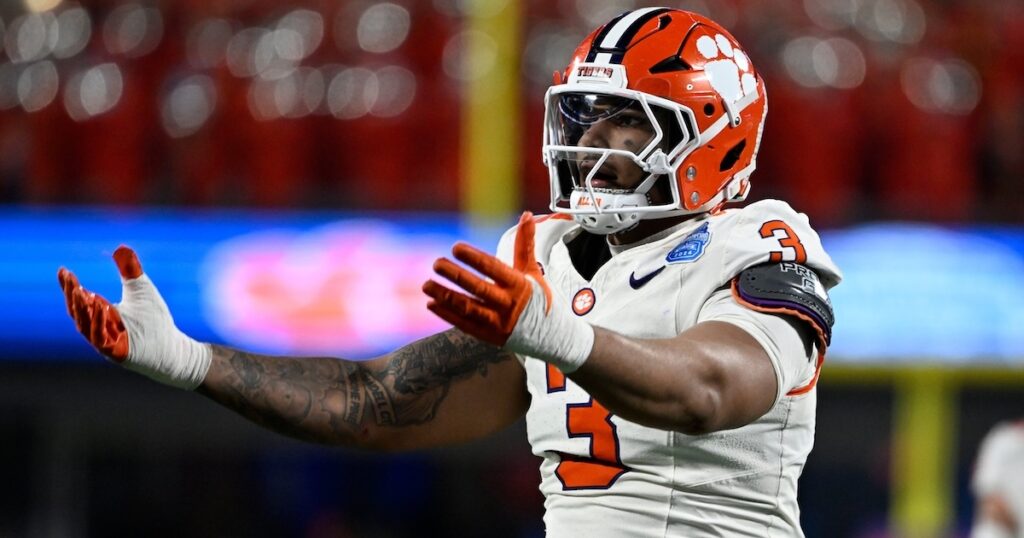
Parker is the second of three Clemson players on Klatt’s top 10 college football players. The EDGE rusher might have a banner year with a teammate who we’ll get to in a second.
Parker was a menace in the backfield last season, logging 20 tackles for loss. He had 57 total tackles and 11 sacks to go along with six forced fumbles as well.
Proctor was dubbed the best offensive lineman in college football per Klatt. The Alabama offensive tackle will be key to the Crimson Tide offense.
Ty Simpson is the projected starting QB and Proctor will have to showcase his freakish abilities to protect him. That could turn him into a high first round pick this spring!
We already broke down Parker on the Clemson defensive line, so here’s another stud defender in college football. Woods will plug up the middle of the line to stuff the run and be able to rush the passer.
Last season, Woods logged 28 total tackles, but nine tackles for loss and three sacks. Expect some gaudier numbers this coming season.
-

 College Sports3 weeks ago
College Sports3 weeks agoWhy a rising mid-major power with an NCAA Tournament team opted out of revenue-sharing — and advertised it
-

 Fashion2 weeks ago
Fashion2 weeks agoEA Sports College Football 26 review – They got us in the first half, not gonna lie
-

 Health2 weeks ago
Health2 weeks agoCAREGD Trademark Hits the Streets for Mental Health Month
-

 Sports2 weeks ago
Sports2 weeks agoVolleyball Releases 2025 Schedule – Niagara University Athletics
-

 Youtube3 weeks ago
Youtube3 weeks agoWill Giannis DEPART Milwaukee⁉️ + How signing Turner & waiving Dame impacts the Bucks | NBA Today
-

 Sports2 weeks ago
Sports2 weeks agoNew NCAA historical database provides wealth of information on championships
-

 Sports2 weeks ago
Sports2 weeks agoAdapti, Inc. (OTC
-

 College Sports2 weeks ago
College Sports2 weeks agoBuford DB Tyriq Green Commits to Georgia
-
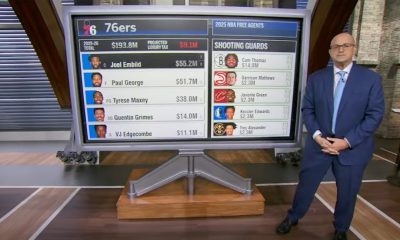
 Youtube3 weeks ago
Youtube3 weeks agoFREE AGENCY BREAKDOWN 🚨 What moves can the 76ers make? 🤔 | NBA Today
-

 Youtube3 weeks ago
Youtube3 weeks agoStephen A. spoke with Deion about Shedeur falling to 5th round 😱 ‘He was devastated’ | First Take




























